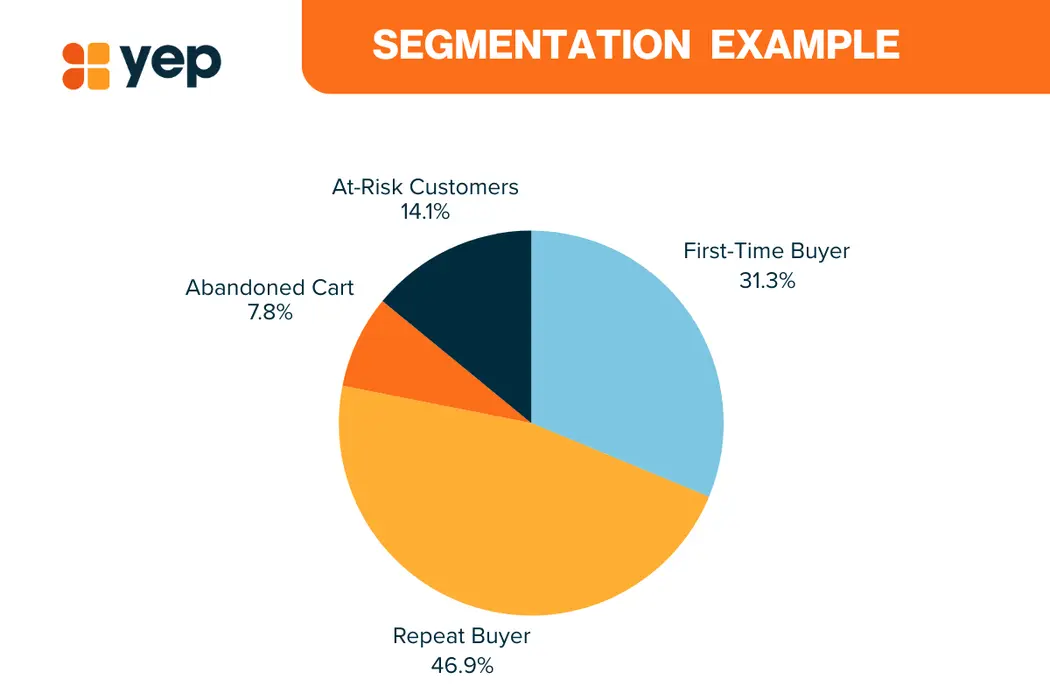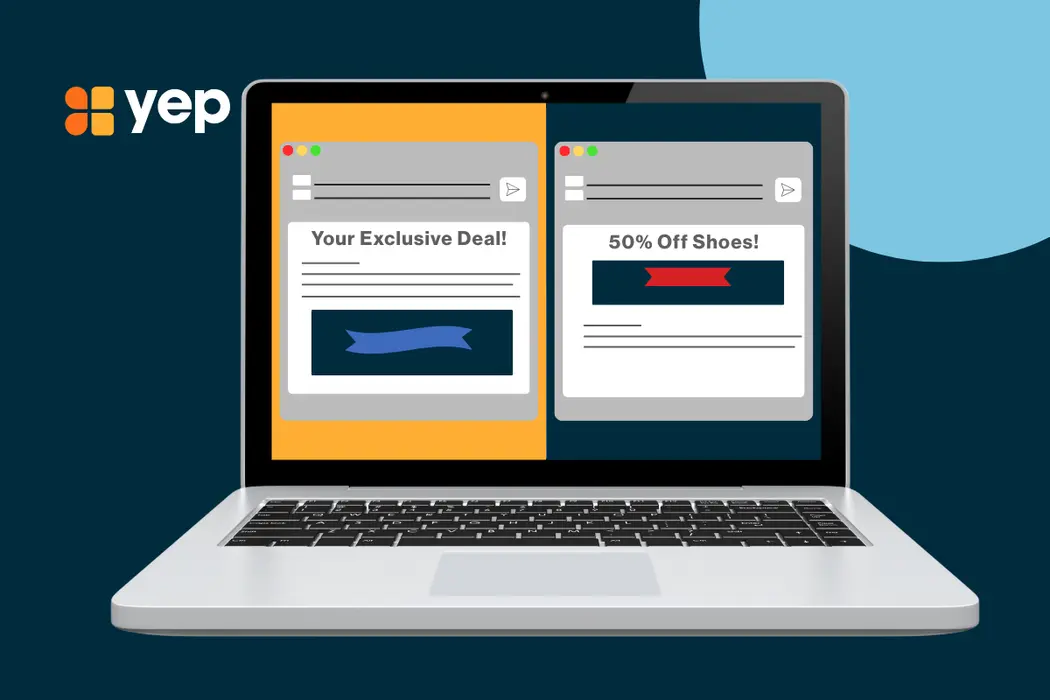
Email Marketing Strategy That Actually Works in 2026
Your inbox is full, and so is your customer’s. But here’s the good news: email is still one of the highest-ROI channels in 2026. For every $1 spent, email returns an average of $36 (DMA). The best way to win? Smarter email marketing strategy.
At Yep Ads, we’ve seen it time and time again: the best-performing campaigns aren’t about sending more emails, they’re about sending the right emails. Just like in performance marketing, success works well when every send has a clear strategy. Let’s break down what makes the difference.
Key Takeaways
- Segmentation + personalization = higher engagement and conversions.
- Clean, clear design drives action.
- A/B testing shows you what actually works.
- Tracking key metrics leads to smarter improvements.
Table of Contents
- Measure, Learn, Improve
- Why Email Marketing needs a strategy, not Randomness.
- Why Segmentation Matters
- Data-Driven Segments = Smarter Campaigns
- Personization Makes It Human
- Design for Clarity, Not Clutter
- Test, Don’t Guess: A/B Testing in Action
- Measure, Learn, Improve
- Final Thoughts
Measure, Learn, Improve
To get real results from your email campaigns, you need to track what’s working and what’s not. These core metrics show how your audience is responding and where to improve:
- Open Rate → Are your subject lines and send times compelling? A low open rate could mean your email isn’t standing out.
- Click-Through Rate (CTR) → Is your content and call-to-action driving action? High opens but low clicks? Your messaging might need tweaking.
- Conversion Rate → Are subscribers completing the goal, like buying, signing up, or downloading a resource?
- Unsubscribe Rate → Too many drop-offs means your emails aren’t hitting the mark. It’s time to adjust targeting, content, or frequency.
Why it matters: These metrics aren’t just numbers; they show what’s actually working in your emails. By tracking and analyzing them, you can optimize your subject lines, content, and CTAs, improve engagement.
Tracking, testing, and optimizing are core to performance marketing at YepAds. Apply the same mindset to your email campaigns for measurable results.
Why Email Marketing needs a strategy, not Randomness.
Without a strategy, your emails can become generic guesswork.
You can prevent this by sending fewer, smarter emails that are segmented, personalized, tested, and measured. When you make every send intentional, you stop cluttering inboxes and start seeing real results for your business
Why Email Segmentation Matters
One of the biggest reasons email campaigns flop is that they treat everyone the same. Think about it: would you send the same message to a brand-new subscriber as you would to a loyal customer who’s purchased three times? Of course not. That’s where segmentation and personalization come in.
Segmentation means dividing your audience into smaller, more meaningful groups. Instead of “one-size-fits-all,” you’re tailoring emails based on what people actually care about. This makes your message more relevant which directly translates into higher open rates, click-throughs, and conversions.
Some practical ways to segment include:
- Behavior → Did they click your last email? Abandon a cart? Download a resource?
- Purchase history → First-time buyer vs. repeat customer.
- Engagement level → Highly active vs. dormant subscribers.
- Demographics → Age, location, or industry (especially useful for wide audiences).
For example, you can segment your customer base in a way that looks like this:

Image source: Yep Ads
At Yep Ads, segmentation is baked into how we approach targeting in performance marketing. The sharper the targeting, the stronger the results.
Data-Driven Segments = Smarter Campaigns
The beauty of segmentation is that it’s powered by data you already have. For example:
- Someone who browsed “running shoes” gets product recommendations from that category.
- Someone who hasn’t opened an email in 60 days gets a re-engagement offer.
- A high-value customer gets exclusive early access to new products.
When your content matches someone’s actual interest or stage in the journey, your emails feel less like marketing and more like service.
And if you’re just starting out, don’t worry! You can still segment effectively without a big history of clicks and purchases. Start simple:
- Ask upfront: Use signup forms to collect basic preferences like product category or location.
- Use demographics: Even age, gender, or region can help tailor messages.
- Track engagement early: Monitor who opens your first few emails and build segments from there.
Over time, the data builds naturally. The key is to set up your systems early so that every new interaction adds to your audience profile.
This is also where Yep Ads can help; by combining affiliate insights with your campaigns, you don’t have to wait months to start seeing patterns.
Email Personalization: How to Make Emails Feel Human
Segmentation gets you halfway there, but personalization seals the deal. And no, we don’t just mean “Hey [First Name]” at the top of your email. True personalization means tailoring content to each subscriber’s interests, behavior, and stage in their journey.
True personalization can include:
- Dynamic product suggestions based on browsing or purchase history
- Location-specific offers like “Toronto, your event tickets are here”
- Behavioral triggers such as “Because you read our last blog…”
- Timing personalization to send emails when they’re most likely to open
- Lifecycle messaging for new subscribers, first-time buyers, or loyal customers
Why it works: your subscribers want to feel recognized. When you personalize their emails, you show you understand what matters to them, building trust while boosting opens, clicks, and conversions.
Just like audience-first content marketing, the best emails put your subscribers front and center. Focus on them, and you’ll see higher opens, clicks, and conversions. Learn more in our audience-first guide.
Design for Clarity, Not Clutter
Even the most relevant email can flop if it’s hard to read. With over 60% of emails being opened on mobile, design isn’t just “nice to have.” It’s essential!
Design tips that boost performance:
- Keep layouts clean with plenty of white space.
- Use short paragraphs, scannable bullet points, and bold headers.
- Stick to one clear call-to-action (CTA).
- Make buttons stand out visually.
At Yep Ads, we’ve seen that simplicity almost always beats fancy graphics. If readers can’t spot the CTA in under five seconds, they’ll move on.
Want to dig deeper? This ties to:
- Landing Page Optimization → Consistency between email and landing page design keeps the user journey seamless.
- Mobile Marketing Best Practices → Most opens happen on mobile, so small screen optimization is a must.
- Creative Testing Guides → A/B testing small tweaks like CTA placement or color can boost clicks.
Test, Don’t Guess: A/B Testing in Action
Guessing is the enemy of growth. The best marketers don’t rely on gut feelings, they rely on data. That’s why A/B testing is essential: so try different subject lines, call-to-actions (CTAs), images, or send times to see what really resonates with your audience.
Example: One brand tested subject lines: “50% Off Shoes” vs. “Your Exclusive Deal Inside.” The benefit-driven “Exclusive Deal” line outperformed the generic discount by 23%. That’s a single tweak but multiplied across thousands of emails, it can dramatically boost engagement and conversions.
Testing isn’t just about chasing metrics. it’s about learning what your audience wants, when they want it, and how they respond. Over time, these insights compound, helping you optimize every part of your campaigns.
With Yep Ads, we take the same approach to affiliate campaigns! Test, measure, and scale. What works gets doubled down on.

Image source: Yep Ads
Final Thoughts
Great email marketing isn’t about sending more, it’s about sending smarter. Segmentation, personalization, design, testing, and measurement all work together to turn inboxes into revenue streams.
At Yep Ads, we help brands and affiliates cut through inbox noise with campaigns built for performance. Ready to see what your emails can really do?
FAQs
How often should I send emails?
It depends on your audience. Start with once a week, monitor engagement, and adjust as needed.
Isn’t email outdated compared to social media?
Not at all. Email consistently delivers one of the highest ROIs across digital channels.
Do I need expensive tools to personalize?
No. Many platforms now offer built-in personalization and automation features. It’s more about strategy than software.
